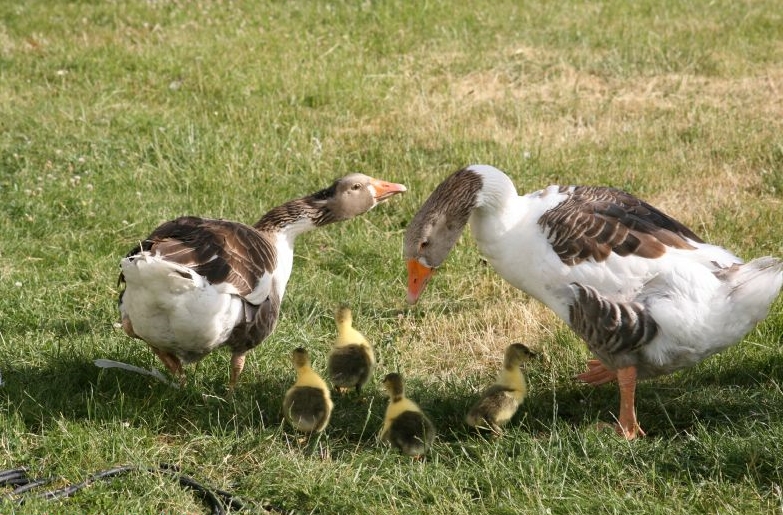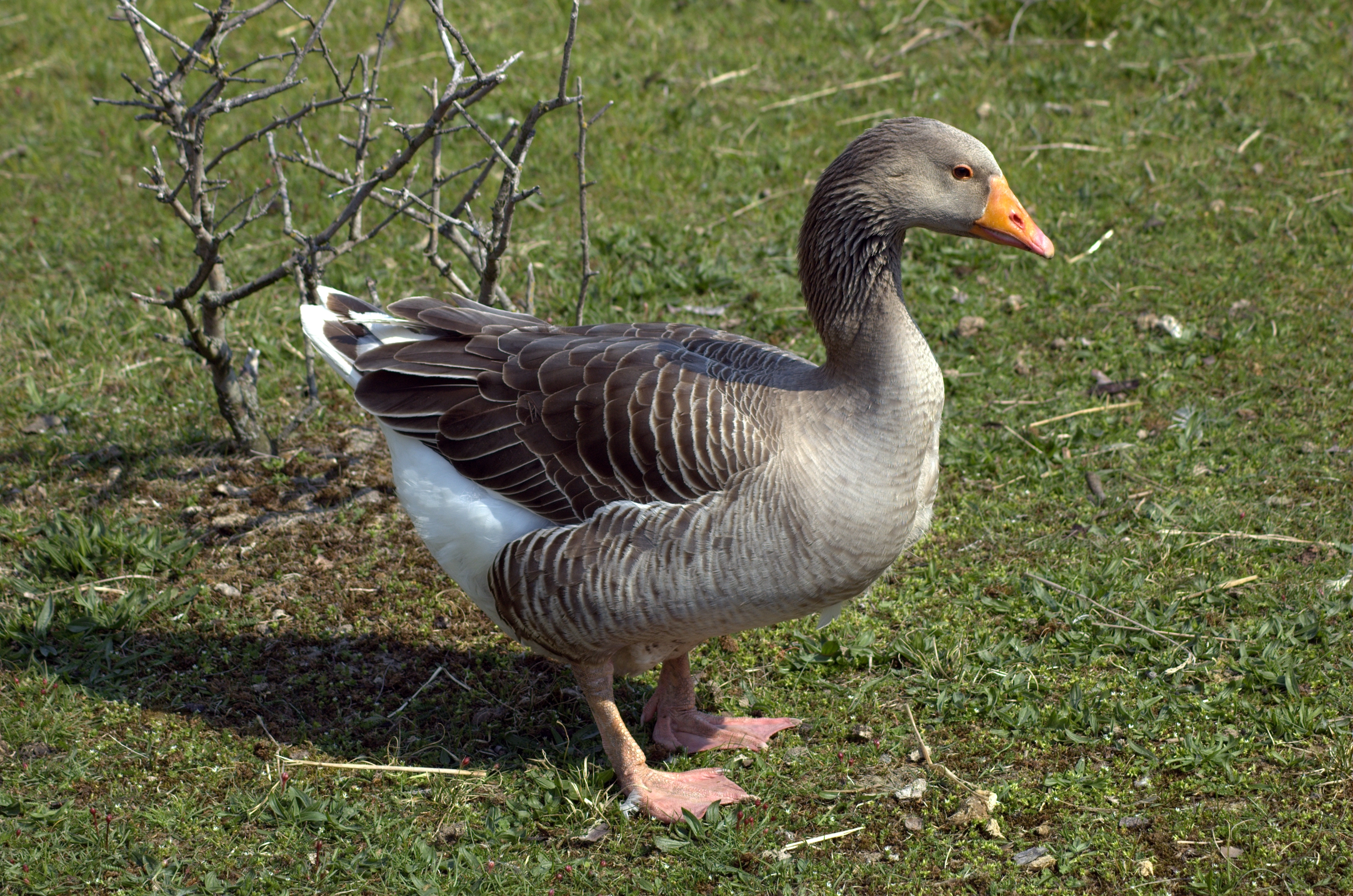|
Scania Goose
The Scania Goose (Swedish: ''Skånegås'') is a breed of domestic geese originating in Scania in Sweden. Origin The Scania goose is a landrace around the towns of Vomb and Hunneberga in Scania, in the south of Sweden. The breed was standardised in the 1920s. In 2011 there were 172 registered animals in Sweden. Description The Scania goose is a large breed similar to the Pomeranian goose, derived ultimately from the greylag goose. The breed is hardy enough to spend the whole year out of doors in southern Sweden. The plumage is white with brown-grey head, neck, back, thighs and rump feathers. The beak and legs are orange; the beak has a flesh-coloured tip. Ganders weigh 7–11 kg, females weigh 6.5–8 kg, making it the largest and heaviest breed in Sweden. They lay around 20–30(–40) eggs and can live for over 30 years. The grey-white egg weighs 200 g. The breed is generally calm and makes good parents. References {{reflist See also * List of goose breeds __NOTOC__ This ... [...More Info...] [...Related Items...] OR: [Wikipedia] [Google] [Baidu] |
Domestic Geese
A domestic goose is a goose that humans have domesticated and kept for their meat, eggs, or down feathers. Domestic geese have been derived through selective breeding from the wild greylag goose (''Anser anser domesticus'') and swan goose (''Anser cygnoides domesticus''). Origins In Europe, northern Africa, and western Asia, the original domesticated geese are derived from the greylag goose (''Anser anser''). In eastern Asia, the original domesticated geese are derived from the swan goose (''Anser cygnoides''); these are commonly known as Chinese geese. Both have been widely introduced in more recent times, and modern flocks in both areas (and elsewhere, such as Australia and North America) may consist of either species or hybrids between them. Chinese geese may be readily distinguished from European geese by the large knob at the base of the bill, though hybrids may exhibit every degree of variation between the two species. Charles Darwin remarked in ''The Variation of Anima ... [...More Info...] [...Related Items...] OR: [Wikipedia] [Google] [Baidu] |
Scania
Scania, also known by its native name of Skåne (, ), is the southernmost of the historical provinces of Sweden, provinces (''landskap'') of Sweden. Located in the south tip of the geographical region of Götaland, the province is roughly conterminous with Skåne County, created in 1997. Like the other former provinces of Sweden, Scania still features in colloquial speech and in cultural references, and can therefore not be regarded as an archaic concept. Within Scania there are 33 municipalities of Sweden, municipalities that are autonomous within the Skåne Regional Council. Scania's largest urban areas of Sweden, city, Malmö, is the third-largest city in Sweden, as well as the fifth-largest in Scandinavia. To the north, Scania borders the former provinces of Halland and Småland, to the northeast Blekinge, to the east and south the Baltic Sea, and to the west Öresund. Since 2000, a road and railway bridge, the Öresund Bridge, bridges the Öresund, Sound and connects Scania ... [...More Info...] [...Related Items...] OR: [Wikipedia] [Google] [Baidu] |
Sweden
Sweden, formally the Kingdom of Sweden,The United Nations Group of Experts on Geographical Names states that the country's formal name is the Kingdom of SwedenUNGEGN World Geographical Names, Sweden./ref> is a Nordic country located on the Scandinavian Peninsula in Northern Europe. It borders Norway to the west and north, Finland to the east, and is connected to Denmark in the southwest by a bridgetunnel across the Öresund. At , Sweden is the largest Nordic country, the third-largest country in the European Union, and the fifth-largest country in Europe. The capital and largest city is Stockholm. Sweden has a total population of 10.5 million, and a low population density of , with around 87% of Swedes residing in urban areas in the central and southern half of the country. Sweden has a nature dominated by forests and a large amount of lakes, including some of the largest in Europe. Many long rivers run from the Scandes range through the landscape, primarily ... [...More Info...] [...Related Items...] OR: [Wikipedia] [Google] [Baidu] |
Landrace
A landrace is a domesticated, locally adapted, often traditional variety of a species of animal or plant that has developed over time, through adaptation to its natural and cultural environment of agriculture and pastoralism, and due to isolation from other populations of the species. Landraces are distinct from cultivars and from standard breeds. A significant proportion of farmers around the world grow landrace crops., and most plant landraces are associated with traditional agricultural systems. Landraces of many crops have probably been grown for millennia. Increasing reliance upon modern plant cultivars that are bred to be uniform has led to a reduction in biodiversity, because most of the genetic diversity of domesticated plant species lies in landraces and other traditionally used varieties. Some farmers using scientifically improved varieties also continue to raise landraces for agronomic reasons that include: better adaptation to the local environment, lower fertilizer r ... [...More Info...] [...Related Items...] OR: [Wikipedia] [Google] [Baidu] |
Pomeranian Goose
The Pomeranian goose (german: link=no, Pommerngans,''Der Große Geflügelstandard in Farbe'', Bd. 3. Wassergeflügel: Gänse und Enten. Oertel + Spörer. French: ''L'oie de Poméranie'' Pomeranian, Toulouse or Emden goose eggs), also known as the Rügener goose, is a breed of domestic goose. Although only an officially recognized breed since 1912, this fowl was developed by Northern German farmers of Pomerania as early as 1500. Ashton, Chris. 1999. ''Domestic Geese''. The Crowned Press, LTD. Ramsbury, England. While it is popular as a market goose throughout Europe FeatherSite: Pomeranian Geese – especially in (Germany), |
Greylag
The greylag goose or graylag goose (''Anser anser'') is a species of large goose in the waterfowl family Anatidae and the type species of the genus ''Anser''. It has mottled and barred grey and white plumage and an orange beak and pink legs. A large bird, it measures between in length, with an average weight of . Its distribution is widespread, with birds from the north of its range in Europe and Asia migrating southwards to spend the winter in warmer places. It is the type species of the genus ''Anser'' and is the ancestor of most breeds of domestic goose, having been domesticated at least as early as 1360 BC. The genus name is from ''anser'', the Latin for "goose". Greylag geese travel to their northerly breeding grounds in spring, nesting on moorlands, in marshes, around lakes and on coastal islands. They normally mate for life and nest on the ground among vegetation. A clutch of three to five eggs is laid; the female incubates the eggs and both parents defend and rear ... [...More Info...] [...Related Items...] OR: [Wikipedia] [Google] [Baidu] |
List Of Goose Breeds
__NOTOC__ This list contains breeds and landraces of domestic geese as well as species with semi-domestic populations. Geese are bred mainly for their meat, which is particularly popular in Germanic languages countries around Christmas. Of lesser commercial importance is goose breeding for eggs, schmaltz, or for the fattened liver (''foie gras''). A few specialized breeds have been created for the main purpose of weed control (e.g. the Cotton Patch Goose), or as guard animals and (in former times) for goose fights (e.g., the Steinbach Fighting Goose and Tula Fighting Goose). Goose breeds are usually grouped into three weight classes: Heavy, Medium and Light. Most domestic geese are descended from the greylag goose (''Anser anser''). The Chinese and African Geese are the domestic breeds of the swan goose (''A. cygnoides''); they can be recognized by their prominent bill knob.APA (2001) Some breeds, like the Obroshin Goose and Steinbach Fighting Goose, originated in hybrids b ... [...More Info...] [...Related Items...] OR: [Wikipedia] [Google] [Baidu] |
Goose Breeds Originating In Sweden
A goose ( : geese) is a bird of any of several waterfowl species in the family Anatidae. This group comprises the genera ''Anser'' (the grey geese and white geese) and '' Branta'' (the black geese). Some other birds, mostly related to the shelducks, have "goose" as part of their names. More distantly related members of the family Anatidae are swans, most of which are larger than true geese, and ducks, which are smaller. The term "goose" may refer to either a male or female bird, but when paired with "gander", refers specifically to a female one (the latter referring to a male). Young birds before fledging are called goslings. The collective noun for a group of geese on the ground is a gaggle; when in flight, they are called a skein, a team, or a wedge; when flying close together, they are called a plump. Etymology The word "goose" is a direct descendant of,''*ghans-''. In Germanic languages, the root gave Old English ''gōs'' with the plural ''gēs'' and ''gandres'' (beco ... [...More Info...] [...Related Items...] OR: [Wikipedia] [Google] [Baidu] |



_head.jpg)

.jpg)